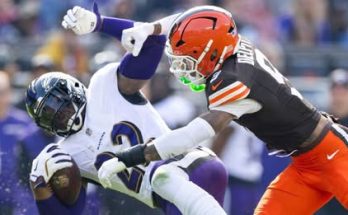Arch Manning is a name that continues to generate excitement in the football world, and for good reason. Despite Texas’ dominant 38–7 victory over San Jose State, the conversation has shifted to Manning’s performance on the field, particularly after Urban Meyer, a seasoned football mind, openly critiqued his accuracy and decision-making. While criticism from a legendary coach like Meyer is certainly noteworthy, it’s equally important to recognize the remarkable aspects of Manning’s play that might otherwise be overshadowed by a focus on a few mistakes. Engaging with this discussion offers fans and observers a chance to explore the nuances of Manning’s game and to weigh both the criticism and the praise in a balanced, thoughtful way.
In the world of sports, especially football, a single game can produce a multitude of narratives. On one hand, Texas’ win over San Jose State was emphatic, a clear demonstration of the Longhorns’ overall team strength. The offensive line controlled the line of scrimmage, the running game was effective, and the defense kept the Spartans in check throughout. In such a team performance, the spotlight naturally shines on the quarterback, the player responsible for orchestrating the offensive attack. Arch Manning, as the face of Texas’ program and one of the most highly anticipated talents in college football, inevitably draws attention and scrutiny.
Critiques like those from Urban Meyer can seem daunting, especially to fans who are enamored with Manning’s potential. Meyer’s observations centered on accuracy and decision-making, aspects of quarterback play that are critical at every level of football. For a young quarterback like Manning, being held accountable for these elements is part of the growth process. Yet, it’s crucial to recognize that even elite players have areas to refine, and a single game rarely tells the full story of a player’s ability. In fact, when considering Manning’s performance against San Jose State, it’s clear that the overall outcome and many individual plays demonstrate skill, composure, and a football IQ that deserves acknowledgment.
One of the most impressive facets of Manning’s play was his ability to remain poised under pressure. Even when throws weren’t perfectly on target or when defensive schemes created difficult angles, Manning displayed patience and maintained situational awareness. In modern football, particularly at the college level, a quarterback’s composure is a differentiating factor. The ability to read defenses, make adjustments, and execute under pressure separates potential stars from the rest of the pack. While critiques of accuracy are valid and necessary for development, they should not obscure the broader context of a quarterback who is demonstrating leadership and control in the pocket.
It’s also worth noting Manning’s physical tools, which continue to excite observers. Arm strength, mobility, and field vision are qualities that are difficult to teach and even harder to replicate. Manning’s performance, even with some inconsistencies, showcased these natural talents. For fans and analysts alike, witnessing a young quarterback with the ability to stretch the field, make plays on the move, and anticipate defensive coverage is both entertaining and indicative of a bright future. These elements, often overshadowed by critiques of isolated decisions, are what make Manning a highly discussed figure and why his performances warrant recognition, regardless of the imperfections highlighted by critics.
Beyond individual talent, there’s also the element of learning from adversity. Every quarterback faces moments where throws are off-target or choices could be better. Football is a game of adjustments, and the ability to respond to critique—whether from coaches, analysts, or peers—is as important as physical ability. Manning’s journey is one that will be scrutinized at every turn, and while critiques like Meyer’s might feel pointed, they also offer opportunities for growth. Engaging with this narrative allows fans to appreciate the process of development in college football, where young stars are learning under the brightest lights, and mistakes are both public and instructive.
Another point to consider is the context of the game itself. Texas’ victory margin over San Jose State was significant, reflecting not just the talent of the players but also the execution of the game plan. While critiques focused on Manning’s accuracy and choices, the team still executed a high-level performance, and Manning contributed meaningfully to the outcome. It’s a reminder that football is a team sport, and evaluating a quarterback requires looking at the entire ecosystem—offensive line protection, receivers’ routes, play design, and defensive pressure. By considering these factors, fans can engage in a more nuanced conversation about Manning’s performance, balancing criticism with acknowledgment of his successes.
Furthermore, discussions about Manning’s development encourage deeper engagement with the game itself. What does it mean for a quarterback to make accurate throws consistently? How do decision-making processes evolve at the college level? Why might a throw be deemed “off” in a certain context but still result in a positive play? These questions spark meaningful conversations among fans and analysts, allowing everyone to explore the intricacies of football strategy, player growth, and performance evaluation. By engaging thoughtfully, fans not only appreciate Manning’s talent but also develop a richer understanding of the game as a whole.
It’s also worth noting that fan perspectives are an important part of this conversation. While critics like Urban Meyer offer expert analysis, fans bring passion, personal observations, and long-term perspectives on a player’s trajectory. When fans engage on posts about Manning’s performance, they contribute to a broader narrative, highlighting plays that might have gone unnoticed or offering alternative interpretations of his choices. In this sense, fan engagement becomes part of the evaluative process itself, providing diverse insights and encouraging a dynamic discussion that moves beyond simplistic praise or criticism.
Moreover, Arch Manning’s performance invites comparisons to other young quarterbacks, past and present. This allows fans to contextualize his growth, understand the challenges of transitioning to high-level college football, and appreciate the unique attributes he brings to the game. Engaging with these comparisons—while respecting the individuality of each player—enriches discussions and invites people to weigh various factors, from leadership qualities to technical skills, in forming their own opinions. By sharing insights, debating plays, and highlighting moments of brilliance, fans contribute to a collective understanding that is both educational and entertaining.
It’s also worth considering the psychological aspect of engagement. Football is not just about statistics; it’s about moments, emotions, and the stories that emerge on and off the field. Discussing Manning’s performance allows fans to connect with the human side of the game, recognizing the pressure, the expectations, and the perseverance required to succeed. When Urban Meyer critiques a player, it’s an opportunity to explore resilience, adaptation, and growth in a high-stakes environment. Engaging with these themes can inspire thoughtful conversations, empathy, and even motivation for young athletes watching and learning from someone like Manning.
Additionally, engaging with posts about Arch Manning encourages communal discussion. Social media platforms, forums, and comment sections are spaces where fans can share knowledge, celebrate accomplishments, and offer constructive critique. This collective discourse fosters a sense of community and belonging among football enthusiasts. By participating in the conversation, fans contribute to a shared narrative, elevating the analysis from mere observation to an interactive exchange that combines expertise, passion, and differing perspectives. Encouraging this engagement ensures that discussions about Manning’s performance are not just one-sided but involve a spectrum of voices.
It’s also important to highlight the balance between critique and recognition. While discussions of accuracy and decision-making are crucial for understanding a player’s development, equally important is the acknowledgment of achievements. Arch Manning displayed moments of brilliance during the Texas-San Jose State game—accurate throws under pressure, smart reads, and effective leadership on the field. Recognizing these aspects creates a more balanced view, fostering appreciation for the complexities of quarterback play. Engaging with posts that explore both strengths and areas for improvement helps cultivate informed, thoughtful dialogue among fans.
Encouraging engagement on this topic also invites fans to reflect on broader themes in football. What does it mean to grow into a high-level quarterback? How do criticism, mentorship, and experience shape performance? How can fans interpret plays within the larger context of team strategy? These questions spark curiosity and allow for deeper appreciation of the sport. By participating in these discussions, fans are not only analyzing Manning’s performance but also enhancing their own understanding of football dynamics, strategic thinking, and player development.
Lastly, engaging with posts about Arch Manning is an opportunity to celebrate the excitement of college football. The sport thrives on anticipation, talent, and the stories that unfold each week. Manning’s journey is a central narrative in this season, and by discussing both the challenges and triumphs, fans keep the conversation vibrant and inclusive. Every insight, every observation, and every debate adds to the richness of the community experience, making following games, performances, and player development an interactive adventure rather than a passive observation.
In conclusion, Arch Manning’s performance against San Jose State should be recognized for its impressive elements, even as critiques from figures like Urban Meyer invite deeper analysis. Encouraging engagement on posts about this game allows fans to explore the nuances of quarterback play, celebrate individual and team accomplishments, and participate in thoughtful discussion about development, strategy, and performance. By acknowledging both strengths and areas for improvement, fans can foster a balanced, informed conversation. Participation in these discussions enhances understanding, creates community, and keeps the excitement of college football alive. Every comment, observation, and debate contributes to a richer narrative, allowing fans to connect, learn, and celebrate the remarkable talent that Arch Manning brings to the field. So, whether you’re analyzing a throw, debating a decision, or praising a play, your engagement matters—join the conversation, share your insights, and be part of the discussion that celebrates both the brilliance and the growth of one of college football’s most exciting young quarterbacks.



